
Thursday, November 05, 2009
Monday, June 01, 2009
Oh. Well, That's innocent Enough.
Here's a rather frightening series of illustrations from a 19th century French inventor's magazine I just bought-
but I know what it looks like to me-

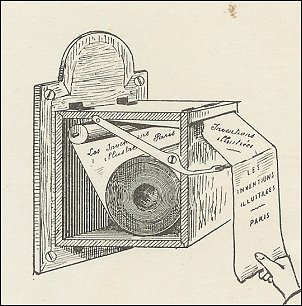
oops. Oh.
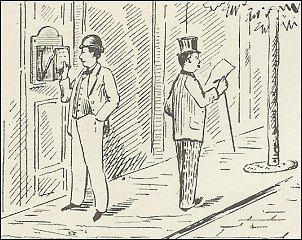
to be read by passersby.
I'm not sure whether this makes me happy or sad...
Tuesday, September 16, 2008
What's that giant sucking sound...?
 Suddenly the stock market seems to have everyone's attention. Yesterday's 500 point loss was certainly dramatic, but represented less than 5% of the NYSE value, and it's what comes next that has really analysts worried. Suddenly everyone knows what AIG stands for.
Suddenly the stock market seems to have everyone's attention. Yesterday's 500 point loss was certainly dramatic, but represented less than 5% of the NYSE value, and it's what comes next that has really analysts worried. Suddenly everyone knows what AIG stands for.The current brouhaha brought back my memories of a really impressive melt-down, that of October 19, 1987. On that Monday, the NYSE plunged 22% -to equal that, todays market would have to lose 2,400 points in a single day. Ouch.
I can remember exactly where I was on Monday, October 19th, 1987- I was on a train to Chicago, where I was going to attend a big book auction on Tuesday. I've never been crazy about flying, so Sunday evening I got on an Amtrak train and headed from Boston to the Windy City, planning to arrive sometime after lunch on Monday and go over to the day-before-auction preview.
Back in Ye Olden Dayes, of course, we didn't have cellphones or WiFi or anything, so when you were on a cross-country train you were essentially cut off from all news of the outside world. When I rolled into Chicago around 1 pm I hadn't heard a word of news all day.
I grabbed a taxi for a ride to the auction house, and got a chatty driver. This was one of the big-city fancy-schmancy auction houses, so I'd put on a tie, and was carrying a briefcase which had my jammies & toothbrush in it, so I probably looked like a disheveled bond trader or something. The driver immediately started making cryptic remarks about "what a crisis, huh?" and "ever seen anything like this before?".
In situations like that I have this odd reflex reaction of trying not to look stupid and playing for time until I can figure out what the Hell is going on, so I made a few non-committal remarks, and we were suddenly at the auction gallery.
I got out of the cab with the odd sensation that the world was ending, and everyone knew it but me.
Big city fancy-schmancy auction houses are not the sorts of places you go up to someone and ask "pardon me, but have you heard a newscast lately?", so I got my catalog and started previewing. All round me the gallery front-office staff, which at places like this is mainly composed of attractive, well-bred young women trolling for well-off art-collecting husbands, had a hushed feeling of dread. They were whispering things to each other like, "my fiance sold all his positions this morning but we got wiped out anyway," and "well, my boyfriend works at the Board of Trade, and he says this could be the end of it ALL".
hehehehehe... I thought- I got to get me to a radio...
...and I eventually found one, playing softly in one corner of the gallery. The newscasters were using comforting phrases like "the worst disaster since the 'Crash of '29".
At times like that I am thankful that my business of buying and selling century-old books lends me a certain long-term perspective on such things. Well, the books and a few stiff scotch-and-waters did, anyway. And the good news was that on Tuesday everyone was completely spooked and I got some good buys at the auction.
And, of course, the markets went back up eventually. So a 500 point drop, or even a 1,000 point drop isn't something to worry about. It's that AIG thing that has me hoarding canned goods and being thankful we have 4 acres of cuttable firewood out back.
And I'm staying off trains.
Saturday, November 17, 2007
Striking a Blow for Historical Accuracy-

I heard this mentioned today on NPR's Wait, Wait, Don't Tell Me! and had to track it down to find out the truth... and here it is-
PLOCNIK, Serbia (Reuters) - If the figurines found in an ancient European settlement are any guide, women have been dressing to impress for at least 7,500 years. Recent excavations at the site -- part of the Vinca culture which was Europe's biggest prehistoric civilization -- point to a metropolis with a great degree of sophistication and a taste for art and fashion, archaeologists say.
In the Neolithic settlement in a valley nestled between rivers, mountains and forests in what is now southern Serbia, men rushed around a smoking furnace melting metal for tools. An ox pulled a load of ore, passing by an art workshop and a group of young women in short skirts. "According to the figurines we found, young women were beautifully dressed, like today's girls in short tops and mini skirts, and wore bracelets around their arms," said archaeologist Julka Kuzmanovic-Cvetkovic.
So it turns out that apparently Raquel Welch was historically accurate, and all the folks who told you that it was just sexist crap were completely anti-historical.
Now all we need to find out is that Betsy Ross did her sewing in a bikini.
I do love the 21st century.
Friday, October 19, 2007
Sox, Stocks, and Memories
 Red Sox Nation is doing the Happy Hamster Dance this morning after last night's win. The series comes back to Fenway Saturday night with Curt Schilling on the mound. Given that Beckett can't pitch every game, there's nobody I'd rather have on the mound for a Big Postseason Game than Schilling.
Red Sox Nation is doing the Happy Hamster Dance this morning after last night's win. The series comes back to Fenway Saturday night with Curt Schilling on the mound. Given that Beckett can't pitch every game, there's nobody I'd rather have on the mound for a Big Postseason Game than Schilling.This Friday's State of Denial post is up on the Wand of Wonder this morning. It has to do with Dick Cheney's future job opportunities...
It was 20 years ago today... that the Stock Market plummeted 508 points, losing almost a quarter of its value, in what became known as "Black Monday". I'll always remember that Monday vividly, because I had boarded a train at Boston's South Station bound for Chicago on Sunday evening. We'd done a book fair Sunday, and there was a book auction in Chicago on Tuesday which I wanted to attend, so I took the Overnighter. We arrived in Chicago early Monday afternoon and had heard no news while we traveled.
I took a cab to the auction house for the preview. Halfway there the driver glanced in the mirror and said, "Shocking Day, huh? Just terrible!"
"Uh huh, yes". I mean, what else do you say?
"What do you think's gonna happen?"
"I don't know". Since I had no idea what he was talking about, it was completely true.
When I arrived at the auction house to preview the books there was an undercurrent of tension everywhere. I overheard the young women on the gallery staff whispering to each other in panicky tones (national financial meltdowns the day before an auction are not a good thing). Beginning to get a bit panicky myself now, I edged over to do some eavesdropping.
"Well," a young 20-something blond was whispering, "my boyfriend works at the Exchange and he says this could be it".
"It" what?
Her friend nodded. "My husband's on the Futures Board and he says he's never seen anything like this. Nobody knows what to do".
Welcome to Chicago. Oh, and the national economy collapsed while you were on the train.
Now, of course, it didn't turn out that way. Stocks steadied the next morning (the national networks provided live coverage of the opening bell, something unheard of in those days before MSNBC, et al) and the market steadied. By the end of the year it had regained all the lost ground and more. But nobody knew that that day. 1929 was our only point of reference. It was scary. And it was disconcerting as Hell to walk into the middle of it not knowing what anyone was talking about. I'll always remember that feeling.
That's a picture of actress Deborah Kerr. She died yesterday, but has left us with wonderful memories.
We're off to a local bookfair, so I may not be checking in before Monday. Have a great weekend, and Go Sox!
Friday, October 05, 2007
"Hey- I Recognize That!"
 This is the story of a gigantic (so to speak) scholarly “oopsie”-
This is the story of a gigantic (so to speak) scholarly “oopsie”-In late 1915 Gisela Richter, renowned expert on Greek and Roman antiquities at New York’s Metropolitan Museum of Art, received a letter from John Marshall, the Museum’s veteran purchasing agent in Italy, describing a newly discovered life-size Etruscan warrior figure in terra-cotta which had been discovered in an Italian field.
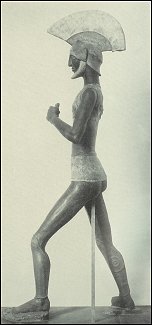 The “old warrior” (he had a white beard and was emaciated, somewhat like, as one observer commented later, a Giacommetti sculpture) was soon followed by a massive four-foot tall terra cotta warrior’s head, and there was even talk of a greater treasure waiting to be found...
The “old warrior” (he had a white beard and was emaciated, somewhat like, as one observer commented later, a Giacommetti sculpture) was soon followed by a massive four-foot tall terra cotta warrior’s head, and there was even talk of a greater treasure waiting to be found...It was, of course, all fakery, carried out on a grand, almost “mythic” scale, a scale meant to make experts put aside all their nagging doubts and see the “Etruscans” as what they were not (namely, ancient). The white-bearded warrior and the massive head had been created by Riccardo Riccardi and Alfredo Fioravanti, two young men of skill and a certain vision. Riccardo’s father and brothers had also specialized in historic pottery, but Riccardo was the true genius of the family. With his friend Alfredo he first created the anorexic, white-bearded warrior.
The figure was modeled as one piece and then broken up into 24 fragments for firing, as the kiln was not large enough to accomodate the entire figure. The warrior is missing his right arm for the simple reason that the two forgers could not agree on how to position the arm, so they compromised by breaking it off and discarding it.
 After selling the figure to the Metropolitan, the pair began work on another figure, this time a gigantic warrior's head. Working from a description by Pliny of a 25-foot tall statue of Jupiter in a Roman temple, the pair made the head four and a half feet tall. This was broken into 178 pieces, fired, and shipped off to the Met. And then Riccardo and Alfredo had to leave to serve their time in the Italian Army.
After selling the figure to the Metropolitan, the pair began work on another figure, this time a gigantic warrior's head. Working from a description by Pliny of a 25-foot tall statue of Jupiter in a Roman temple, the pair made the head four and a half feet tall. This was broken into 178 pieces, fired, and shipped off to the Met. And then Riccardo and Alfredo had to leave to serve their time in the Italian Army.When they returned they began their most audacious project yet- a Colossal Warrior in terra cotta, standing over eight feet tall. Then tragedy struck. Riccardo was killed in a fall from his horse that winter, and his place was taken by two less-skilled cousins. As with the earlier pieces, the statue had to be fired in pieces as it was much too large for the kiln.
It proved, in fact, to even be too large for the room it was being modeled in, and by the time they had modeled up as far as the waist it was obvious that the elegant classical proportions of genuine Etruscan sculpture would have to be ignored -there simply was not enough room for the upper body without going through the ceiling. The odd result- classical legs and a stocky, disproportionate torso, troubled some scholars.
 In 1921 the Met. purchased the warrior for an undisclosed price said to have approached 5 million dollars in today’s money. The statue was reconstructed from the fragments by the Met's experts with one odd exception- the genitals, which had been carefully modeled (the warrior, like many Etruscan statues, was partially nude from the waist down) were left off and apparently kept in storage. It may have been just as well.
In 1921 the Met. purchased the warrior for an undisclosed price said to have approached 5 million dollars in today’s money. The statue was reconstructed from the fragments by the Met's experts with one odd exception- the genitals, which had been carefully modeled (the warrior, like many Etruscan statues, was partially nude from the waist down) were left off and apparently kept in storage. It may have been just as well.One story that came to light later related that while the body of the figure was based upon that of Riccardo's cousin and helper Teodoro, the "privates" were modeled after Riccardo's own, and had been recognized by a number of young Italian ladies of his hometown...
Attempts to erase doubts that were already being whispered in art circles in Europe, as well as the hope that the “secret” field they had been found in might be divulged by their “discoverers”, delayed the publication of a scholarly monograph on the three figures until 1937. For Richter, bringing them to the Met. and publishing them represented one of the crowning achievements of her distinguished career, and it was undoubtedly this fact that blinded her to what was becoming all too obvious to other scholars who were not emotionally or professionally attached to the warriors.
The talk about their true origins swirled quietly for the next decade or two, but after a visiting Italian scholar was offered a chance to see all three statues in 1959, and commented that he did not need to see them since he knew the man who had made them, authorities at the museum decided something had to be done. In 1960 a series of tests concluded that the glazes on all three specimens contained chemicals which had not been in use before the 17th century, and in 1961 Fioravanti signed a confession of the whole affair, and supplied a missing thumb which fit perfectly.
At that point several other “bothersome” points that had been noted over the years began to make more sense- the Colossal Warrior, for instance, could not even support its own weight, and when compared to real Etruscan statuary, simply looks crude and even modern. Today the statues are stored far away from prying eyes, but they still provide an entertaining and sobering lesson in fake busting.
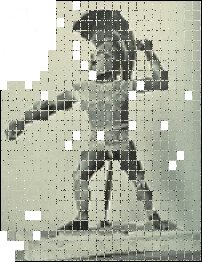 A much more detailed account of the warriors was written by David Sox in his excellent book “Unmasking the Forger, The Dossena Deception” (1987), from which most of the material for this essay was taken; Thomas Hoving, the former Director of the Met., also deals with the story, and speculates on the role of John Marshall, in his book "False Impressions: The Hunt for Big-Time Art Fakes" (1996).
A much more detailed account of the warriors was written by David Sox in his excellent book “Unmasking the Forger, The Dossena Deception” (1987), from which most of the material for this essay was taken; Thomas Hoving, the former Director of the Met., also deals with the story, and speculates on the role of John Marshall, in his book "False Impressions: The Hunt for Big-Time Art Fakes" (1996).
Thursday, July 26, 2007
These Were Your Grandfather's Cornflakes...

Monday, July 23, 2007
The Affair of the Diamond Necklace- Part 2
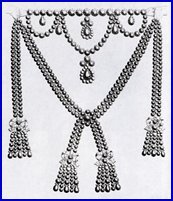 Our story so far...
Our story so far...The first Marie Antoinette knew of her "purchase" of the necklace was when the jewelers (most humbly and very, very anxiously) sent her a dunning letter for the gigantic unpaid bill. Then, as they say, all Hell broke loose. The scandal became public; the Cardinal was denounced, and Jeanne was arrested along with just about everybody else who had ever as much as shaken hands with the Cardinal.
Acting against some very good advice, Marie Antoinette insisted on a trial for the Cardinal on the charge that he was guilty simply because he had believed that she was capable of having the sort of "relationship" with him he had thought she had. This, of course, played right into the hands of the Queen's numerous enemies who were only too happy to have publicly broadcast the exact nature of what the Cardinal had thought were the Queen's morals, or lack thereof.
There followed a sensational trial, which was ostensibly about the Cardinal's actions but was really about the Queen's reputation. Jeanne's lawyer was Maitre Doillot, a respected advocate who was in somewhat over his head in dealing with Jeanne. He was the family lawyer of the Paris Police Lieutenant General, and had been recommended to Jeanne by that worthy as a favor -for what we will not speculate, though many others did at the time. The Count Beugnot, himself a lawyer (and another one of Jeanne's former lovers) had turned down her plea that he defend her, and had this to say about Maitre Doillot-
 "Doillot had been in practice before the Paris bar for many, many years, and not without renown. Deep in his sixties or beyond, he had retired to his study, where he was still consulted as an eminent jurist. Even a sage old gentleman such as this could not with impunity survive close contact with the Countess de la Motte. She completely turned his head. He believed implicitly all the tales she spun him, became emotionally involved with his client and put up an impassioned defense of her innocence, making his debut in the case with the publication of a trial brief, the most extravagant defense plea ever to flow from the pen of an attorney in all the years since attorneys first began composing defense pleas. Fantastic as a tale out of 'The Arabian Nights', it enjoyed, nonetheless, a sensational success. And to think that it was the composition of a venerable white-wig of seventy summers!".
"Doillot had been in practice before the Paris bar for many, many years, and not without renown. Deep in his sixties or beyond, he had retired to his study, where he was still consulted as an eminent jurist. Even a sage old gentleman such as this could not with impunity survive close contact with the Countess de la Motte. She completely turned his head. He believed implicitly all the tales she spun him, became emotionally involved with his client and put up an impassioned defense of her innocence, making his debut in the case with the publication of a trial brief, the most extravagant defense plea ever to flow from the pen of an attorney in all the years since attorneys first began composing defense pleas. Fantastic as a tale out of 'The Arabian Nights', it enjoyed, nonetheless, a sensational success. And to think that it was the composition of a venerable white-wig of seventy summers!".The Abbe Georgel called Doillot's first plea "a tissue of lies, of striking improbabilities, contradictions and anachronisms". Doillot's own brother agreed-
"The man has either gone stark raving mad or Madame de la Motte has bewitched him as she did the Cardinal".
After much scandal mongering in both the courtroom and the streets the Queen's enemies won and the Cardinal was acquitted. Others were not so lucky- the Count Cagliostro was exiled from France, and eventually returned to Italy where he was arrested and convicted on charges of practicing Freemasonry; he died in prison in 1795.
Jeanne was convicted and whipped, branded, and thrown into the Bastille at which point she may (or may not) have had a fling with its Governor, the poor Launay, who would lose his head at the hands of the mob when they stormed the ancient fortress a few months later.

Jeanne was now a favorite of the anti-Antoinette faction, which was growing quickly in France, and she was able to intrigue to escape the country and made her way, with her husband, to London.
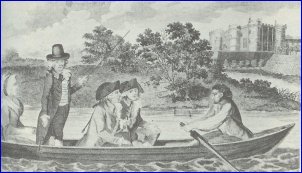
Once there she immediately set out on a plan of revenge against the Queen which took the form of her famous "Memoires Justificatifs de la Comtesse de Valois de la Motte". These contained her own highly slanted version of her life and the Diamond Necklace Affair, as well as some thirty pieces of correspondence she claimed had passed between the Cardinal and the Queen.
"From the moment of my arrival in London," she wrote, "my first and only thought had been publication of my justification for the eyes of all the world... I too would have preferred to spare the honour of the Queen, and I tried to warn her Majesty that I was in Possession of certain letters...incriminating her and exculpating me... All I asked in return was restitution of property rightfully mine which had been seized, after an iniquitous verdict, to enrich the coffers of the King. But I really never considered it likely that the French court would capitulate to those terms, and besides, my main goal was public vindication. To this purpose, then, I eagerly took up my pen, denying my feeble, tortured body even the minimal physical requirements of nourishment and sleep until my memoirs should be ready for publication. Although we were obliged to borrow money to defray the costs of printing, five thousand copies in French have now come off the press, and three thousand more in English; the latter went on sale at a guinea each in New Bond Street shops."
The readers of England and France could not get enough of the Countess's memoirs, although what you thought of them depended on which side of the Royal table you sat on- "a cesspool of calumny" was the verdict of the Abbe Georgel, friend and secretary of Cardinal Rohan. In October of 1789 a "Second Memoirs justicatif", much more barbed and venomous than the first, was rushed to the printers, another direct attack on the Queen by Jeanne, published in French and English and distributed in Paris where it stirred the mobs to a new frenzy.
Mirabeau said of the Countess- "Madame de La Motte's voice alone brought on the horrors of July 14 and of October 5" (the storming of Versailles and the slaughter of the troops there by the 'Women's Army').
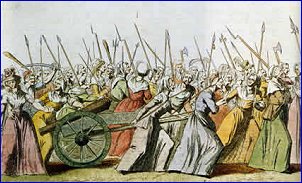
Her works spawned a storm of other pamphlets, each one trying to outdo the other in decrying the licentiousness and debauchery of the Queen. Frances Mossiker, in "The Queen's Necklace", notes, however, that's Jeanne's works were the most influential-
"There were other attacks perhaps more obscene, but they were published under noms de plume and therefore were never as pungent and convincing as those signed by a real-life name, a name famous, moreover, throughout Europe ever since the Necklace Trial".
In 1791 the Countess's two volume "Story of My Life" came off the presses, but Jeanne would not live to enjoy its fruits. In early June the London newspapers reported that a London bailiff had appeared at her lodgings to serve an order for her mounting debts. Others said that the men were actually secret agents sent by the Duke of Orleans; that was what Jeanne believed, and to get away from them she barricaded herself in and then climbed out a third floor window, falling to the street below. Badly injured, she lingered in extreme pain through the hot weeks of July and into August, when, on August 23rd, 1791, she died. She was buried a few days later in the churchyard of St. Mary's, in Lambeth.
The Queen against whom Jeanne had intrigued for so long survived her by just two years, one month, and 23 days, before mounting the steps to the guillotine in Paris to the howling delight of the mob.
Thursday, July 19, 2007
The Affair of the Diamond Necklace-
"The Queen's death must be dated from the Diamond Necklace Trial".
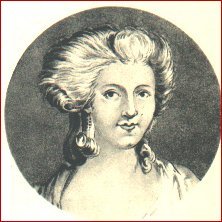 The trial, and the subsequent Memoirs of its chief feminine player, the Comtesse de la Motte, are credited by many historians with being the gust of foul wind which finally fanned the long-smouldering fire of popular discontent into the uncontrollable conflagration of the French Revolution.
The trial, and the subsequent Memoirs of its chief feminine player, the Comtesse de la Motte, are credited by many historians with being the gust of foul wind which finally fanned the long-smouldering fire of popular discontent into the uncontrollable conflagration of the French Revolution. The tale is long, complex and sordid; it has several different versions (depending on whose memoirs you read), and has been told many times, most recently in a beautifully costumed Hollywood version starring Hilary Swank. The movie, which includes a stirring performance by Miss Swank as the Countess, takes some (but not all) of the Countess's claims at face value, which is another way of saying that it takes extreme liberties with what most historians regard as the actual truth.
The tale is long, complex and sordid; it has several different versions (depending on whose memoirs you read), and has been told many times, most recently in a beautifully costumed Hollywood version starring Hilary Swank. The movie, which includes a stirring performance by Miss Swank as the Countess, takes some (but not all) of the Countess's claims at face value, which is another way of saying that it takes extreme liberties with what most historians regard as the actual truth.Although she claimed to be descended from royalty, it is now generally agreed that Jeanne de Saint-Remy de Valois, Comtesse de la Motte, came of what might be termed "humble origins" and basically talked, schemed and slept herself almost all the way to the Royal Chambers at Versailles.
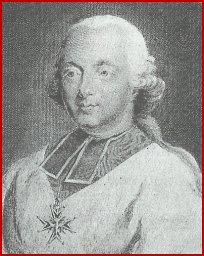 Jeanne carried on an affair with the Cardinal Louis Rene Edouard, Prince de Rohan, a man more attuned to matters earthly than spiritual. Jeanne also borrowed money from the Cardinal, and was soon deep in his debt. For his part the Cardinal was out of favor with Marie Antoinette, and was anxious to get into the Queen's good graces, if not her bed. Jeanne, who was undertaking her own campaign to gain access to the Queen and have her "family estates" "returned" to her, persuaded the Cardinal that she had the Queen's ear and could arrange reconciliation.
Jeanne carried on an affair with the Cardinal Louis Rene Edouard, Prince de Rohan, a man more attuned to matters earthly than spiritual. Jeanne also borrowed money from the Cardinal, and was soon deep in his debt. For his part the Cardinal was out of favor with Marie Antoinette, and was anxious to get into the Queen's good graces, if not her bed. Jeanne, who was undertaking her own campaign to gain access to the Queen and have her "family estates" "returned" to her, persuaded the Cardinal that she had the Queen's ear and could arrange reconciliation.The gullible and perhaps somewhat oversexed Cardinal agreed and the Countess arranged a correspondence between him and the Queen. His letters to Marie Antoinette were real enough, but never delivered; the Queen's return letters were forgeries produced by Jeanne herself, or possibly her husband, or perhaps her "secretary" and lover, the gallant former-cavalier Retaux de Vilette.
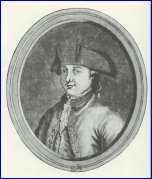
 The famous and scandalous Count Cagliostro, alchemist, healer and all-round man-of mystery, had been befriended by the Cardinal, and the Cardinal relied on Cagliostro's direction and ability to see into the future to direct his dealings with the "Queen". Cagliostro, who was nobody's fool, went into trances and told the Cardinal that he saw the Cardinal being favored by the Queen and rising to a very high post in the government.
The famous and scandalous Count Cagliostro, alchemist, healer and all-round man-of mystery, had been befriended by the Cardinal, and the Cardinal relied on Cagliostro's direction and ability to see into the future to direct his dealings with the "Queen". Cagliostro, who was nobody's fool, went into trances and told the Cardinal that he saw the Cardinal being favored by the Queen and rising to a very high post in the government. The diabolical farce seemed to reach its climax with a midnight rendezvous in the Grove of Venus at the Palais-Royal Gardens, between the Cardinal and "Marie Antoinette" -actually an actress (or prostitute, or perhaps both, who could keep track at this point?) named Mademoiselle Leguay d'Olivia, who bore a remarkable resemblance to the Queen... and then the extravagant and fabulously costly diamond necklace entered the scene.
Ah, the necklace...
 The Diamond Necklace had been made several years earlier "on speculation" by a firm of Parisian jewelers who had assumed they could sell it to Madame du Barry. When that did not work out they tried to interest Marie Antoinette in the necklace, and although she had been tempted, she considered it too extravagant and had refused to purchase it. Now the jewelers, teetering on the edge of bankruptcy because of the interest payments on the money they had borrowed to buy the stones, approached the Countess, who openly boasted about how close she was to the Queen, and asked her to persuade Antoinette to buy the overwrought bauble which was worth as much as a full-rigged warship.
The Diamond Necklace had been made several years earlier "on speculation" by a firm of Parisian jewelers who had assumed they could sell it to Madame du Barry. When that did not work out they tried to interest Marie Antoinette in the necklace, and although she had been tempted, she considered it too extravagant and had refused to purchase it. Now the jewelers, teetering on the edge of bankruptcy because of the interest payments on the money they had borrowed to buy the stones, approached the Countess, who openly boasted about how close she was to the Queen, and asked her to persuade Antoinette to buy the overwrought bauble which was worth as much as a full-rigged warship.Jeanne shrewdly took the matter to the Cardinal, who was very much inclined to negotiate a purchase he thought would endear him further to Marie. Once more the Cardinal consulted the Count Cagliostro, and once more Cagliostro went into a trance and foresaw the Cardinal enriched and rewarded by the Queen with a post at the highest rank of the government.
More outrageous lies, deception and forged letters ensued, and in the end the Queen agreed to purchase the necklace, or so the lovesick Cardinal and desperate jewellers were led to believe. The jewelers delivered the necklace to the Cardinal, and the Cardinal delivered it to a trusted servant of the Queen (or so it appeared) and then the necklace simply vanished!
Gee, bet you didn't see that coming, eh?
Next: Scandal, Trial, & Revolution!
Friday, June 29, 2007
Friday, June 08, 2007
Not Your Daddy's Chevy...
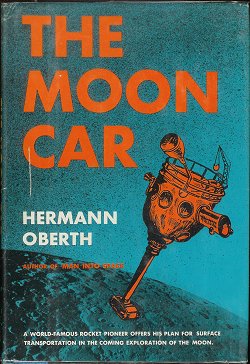
Rocketry pioneer Hermann Oberth published this little gem of a book in 1959. Oberth was born in Transylvania in 1894, read a lot of Jules Verne as a child and had a long and mostly distinguished career. Of course there was that embarrassing period during World War 2 when he was making rockets for the Nazis, but such 'issues' didn't seem to be much of a problem for scientists with skills America wanted during the Cold War, and in 1950 Oberth came to the United States to work with fellow ex-Nazi- er, I mean fellow scientist, Wehrner von Braun.
Always a forward-thinker, Oberth wrote several books on the future of rocketry and space travel, of which this is my hands-down favorite. Oberth's Moon Car has everything you need for a comfortable lunar stay, including a patio, complete with a derrick for winching supplies on board, a suspended beer keg, and a newspaper box-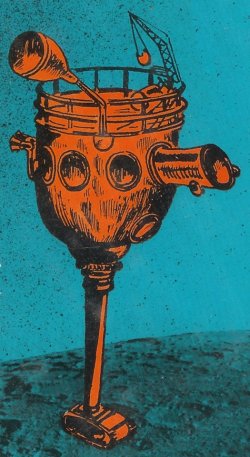
But of course the cheapskate fuddy-duddies at NASA went bare-bones and bought this instead-

And they didn't even spring for the extended warranty, so the damned things still up there.
and so it goes...
Wednesday, June 06, 2007
Out for a Stroll Down by the River... why?
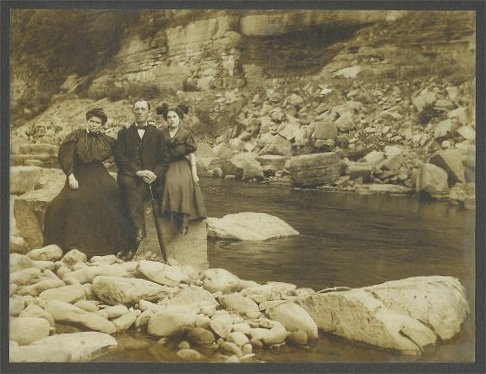
I loved this photo the second I saw it, with its formally dressed, starched-collar family perched (seemingly) comfortably atop a boulder in a rugged river canyon. Anyone who has ever hiked in the canyons of Utah or Arizona will appreciate the difficulties involved in traveling along a rock-strewn river bank in patent-leather shoes, not to mention dressing in dark, volumous clothes, as these good people were, with the harsh sun beating down on you.
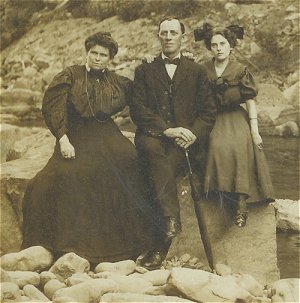
We've come a long way in terms of dressing comfortably for such activities in the past seventy-five years or so. Of course, these days we do have to change before dining at the lodge...
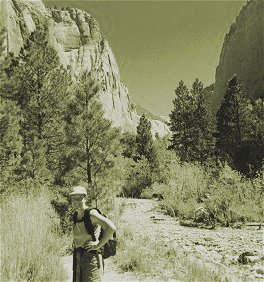
The photo shows some interesting details- a high white collar, cross and long gold chain worn by the mother, stiff collar and bowtie on the father, and short gold choker with what appears to be a cross, along with an enormous hair ribbon, worn by the daughter-
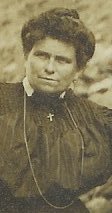


The father's shiny black dress shoes and the dainty bow-topped shoes the daughter is wearing were simply not made for climbing across wet rocks-
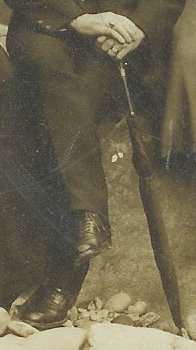


The father's umbrella and multiple gold rings, and the daughter's gold bracelet are nice touches in this wonderful picture. Obviously Victorian-era hikers were made of sturdier stuff than we are today... but maybe not. A few years ago Amy and I were visiting Bryce Canyon and we went on an afternoon hike along one of the longer trails. We'd been hiking in the back country of southern Utah the week before, and so we automatically put on our big hiking boots, and carried our backpacks with snacks and plenty of water. You're unlikely to get into too much trouble in Bryce, but hey, why take chances? Toward the end of the hike, on the way up, out of the canyon, we passed a group of French women tourists on their way down. They were all immaculately dressed and coifed, and many were wearing fashionable black pumps. Chatting happily with each other and evidently having a grand time, they could just as easily have been walking down 5th Avenue in New York. As we trudged by them in our boots and backpacks, we felt terribly over-dressed. Maybe it's all just a state of mind...
Thursday, May 03, 2007
I Can't Hear You...
Well, I've come across another example, of sorts, this time on the bookplate of book and type designer W.A. Dwiggins. This dates from the early 1930s-

Very stylish, I think.
Tuesday, May 01, 2007
May Day!
Friday, April 27, 2007
Father Himalaya-
 I'm afraid I'm a bit behind in blogging this week- we were in New York for four days last week through the weekend, and then I had to rush to get the new catalog to the printer. But now that's all done, and as I was sitting here, browsing through images on my computer, I came across the picture you see to the left, which is part of a very interesting tale...
I'm afraid I'm a bit behind in blogging this week- we were in New York for four days last week through the weekend, and then I had to rush to get the new catalog to the printer. But now that's all done, and as I was sitting here, browsing through images on my computer, I came across the picture you see to the left, which is part of a very interesting tale...We once had a book which had the ownership inscription of a "Father Himalaya". Being curious, I did some digging and discovered a really amazing man-
Manuel Antonio Gomes 'Himalaya' [1868-1933] was known as "Father Himalaya", and is considered to be the father of solar energy in Portugal, and a visionary pioneer in the field of renewable energy. After taking Holy Orders in the Society of Jesus he studied natural sciences, physics, chemistry, mathematics and astronomy, and traveled to France where he studied with the noted chemist Marcelin Berthelot. In 1899 he was granted a patent by the French government for a device to produce heat by focusing the sun's rays.
In 1900 he constructed a test device in the Pyrenees and attained a temperature of 1100 degrees centigrade. In 1902 an experiment in Lisbon attained 2000 degrees, and he made a final, startling demonstration of the power of such a device at the St. Louis Exposition in Missouri 1904. There he constructed his "Pireliofero" (that's it in the picture), a 3-story high parabolic mirror mounted on a monstrous iron framework which focused sunlight on an oven mounted opposite the mirror. The oven reached a temperature of 3500 degrees, melting a test chunk of basalt, and Father Himalaya won a Grand Prize for his efforts.
He promoted other forms of renewable energy as well, including tidal energy and hydroelectric power, wind power, and geothermal power. Alas, there was plenty of cheap coal and oil available, and his work was generally ignored and forgotten. Father Himalaya retired to become chaplain at Viana Castle, a charity home, where he died at the age of 65. His work has excited interest in Europe in recent years, and his ideas have only lately attained a measure of the respect which eluded them in his lifetime.
That's what I love about bookselling- you find out all sorts of things you didn't even know you were looking for.
Wednesday, April 11, 2007
Trilobites and Fossils and Megatheriums- OH MY!!
 In the 19th and early 20th centuries it was accepted practice to furnish museums with casts of all types, from classical statues to trilobites, and I thought I'd share some illustrations from an interesting trade catalog, published in 1866, which served the latter trade.
In the 19th and early 20th centuries it was accepted practice to furnish museums with casts of all types, from classical statues to trilobites, and I thought I'd share some illustrations from an interesting trade catalog, published in 1866, which served the latter trade.Henry A. Ward's "Catalogue of Casts of Fossils, from the Principal Museums of Europe and America, with short descriptions and illustrations" , offered for sale a complete and comprehensive listing of fossils, from minute Ammonites to a complete Plesiosaur or a Megatherium, many taken from originals at the British Museum.

In the 1860s and 1870s dinosaurs were not yet a major subject for study- few had been discovered. Paleontologists were very excited though, by earlier plant and animal life, as shown here, and especially by another set of animals amply illustrated here- early mammals. The fight to discover and name early mammals was at least as heated as the dinosaur wars which would erupt a few decades later, because it was through these fossils that scientists were slowly attempting to prove Darwin's controversial theory of Evolution.
Ward catalogs everything in a scientific manner and also includes fossil tracks, and even replicas of the models shown at the Crystal Palace. At the rear of the catalog he offers skins and skeletons of contemporary American animals and also, grotesquely, "Aborigines -Indians of various Western Tribes: Skulls, from $15 to $25 each. (These are taken fresh, not disinterred from old graves)".

Henry Ward was one of the most interesting and omnipresent characters in Victorian natural history. After making a fortune supplying museums with natural history and paleontological exhibits he turned his attention to meteorites with the same zealous thoroughness. The chronicle of Henry A. Ward's career and various interests is well covered in Roswell Ward's 1948 biography.
I thought I'd finish here with the fold-out plate of a cast of one of the most famous fossils of the day, the Megatherium. My apologies- it's too wide to present here in a decent size unless I turn it on its' side-




